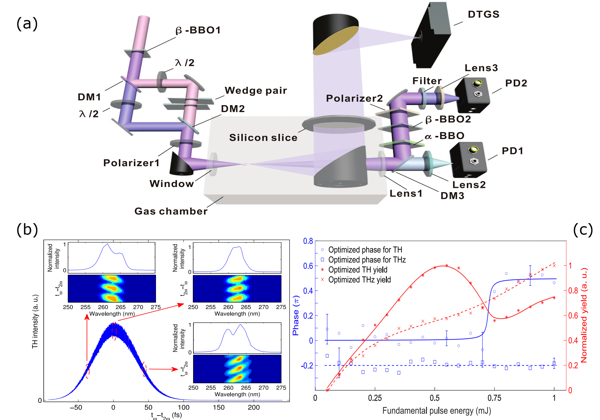Low-order harmonic generation in gases pumped by ultrashort near-IR femtosecond laser pulses is an important technique to generate ultraviolet (UV) and vacuum ultraviolet (VUV) light sources, which can be used in a wide variety of applications for ultrafast time-resolved spectroscopy, subcycle pulse synthesis and frequency-comb technology. Experimental and theoretical studies have both demonstrated that the third-harmonic generation (THG) yield of a one color laser field in air is determined by various characteristics, including laser intensity, pulse duration, focusing conditions, air pressure, etc. The underlying mechanism for an intense laser pulse propagating over long distances in optical media is the dynamic interplay between the Kerr self-focusing due to the nonlinear refractive index and the defocusing due to a low density electron plasma.
Compared to the case of the one-color laser field, the four-wave mixing of 800 nm pulse and its second harmonic can produce TH pulses with a higher conversion efficiency of more than 13%. From the single-atom perspective, THG is considered as nonlinear parametric conversion, mainly by a direct THG channel, 3ω = ω +ω +ω, and a four-wave mixing (FWM) channel, 3ω = 2ω +2ω - ω. The relative phase delay plays a key role and it is hardly accurate determined experimentally. To pursue high conversion efficacy of the THG, the strong pump laser is normally focused to ensure strong ionization of the gas medium, in which THG yield is considered to be dominated by the nonperturbative nonlinear response of free electrons, i.e., the tunnel ionization current. Recently, the dependence of the THG mechanism on the pump intensity has been theoretically investigated by a numerical simulation based on the time-dependent unidirectional pulse propagation equation. However, to the best of our knowledge, there is an overall lack of experimental investigation regarding the optimized phase delay of the THG in gases induced by a two-color field at various pump laser intensities.
The research group led by Professor Zengxiu Zhao from National University of Defense Technology used the 800+400nm femtosecond laser pulses to study the generation mechanism of THG at various pump laser intensities based on the phase dependence in Chinese Optics Letters, Vol. 21, Issue 5, 2023 (Congsen Meng, et al., Phase dependence of third-order harmonic generation in gases induced by two-color laser field).
In this work, we experimentally studied the mechanism of the THG as changing the fundamental laser intensity with a two-color laser field. In the low-intensity regime, it is found that the THG originates from a third-order nonlinear process, that is, direct and FWM channels, which has been experimentally demonstrated, respectively, and the interference of these two channels has been verified. With a relative phase monitor, a joint measurement of the THz and the TH emissions, as shown in Figure (a), was carried out precisely by varying the phase delay in attosecond precision. If the two pump pulses are incompletely overlapped, then the TH spectrum exhibits an asymmetric pattern arising from the FWM process with a broad spectrum of pump pulses, as shown in Figure (b).

Figure (a) Experimental setup for the synchronous measurements of the THz and
TH emission; (b) TH spectra obtained at three different time delays; (c) The optimized phase and the optimized yield for the TH and the THZ, respectively.
Furthermore, the dependence of the optimized THG yield and the optimized phase of the fundamental intensity is experimentally investigated, as well as that of the THz. Figure (c) shows the optimized phase for the THG jumps from 0 to 0.5π as the pump intensity increases, which is different from the THz being a constant, and indicates that the THG arises from the nonlinearity of the third-order bound electrons to the tunnel-ionization current. Our research provides further understanding of the mechanism of THG in gases and facilitates generating an efficient TH source for applications.


